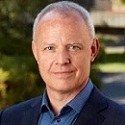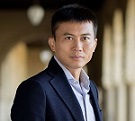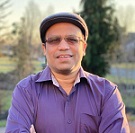
From the Director

Looking forward, we send our best greetings for 2021. The DOE and SLAC management have been very supportive of SSRL and the user program through the pandemic. We appreciate your patience and support as we continue to work through and adjust as the conditions evolve. SSRL beam line staff will continue to contact users to discuss beam time requests, determine which experiments can be performed within current COVID-19 constraints and coordinate sample handling. Although x-ray experiments are primarily being performed either by remote access or by beam line staff through mail-in samples, we are optimistic that we will be able to gradually re-introduce users to the SSRL experimental floor later this year beginning with local (Northern California) users.
– Paul McIntyre
Science Highlights

Reversible Multicolor Chromism in Layered Formamidinium Metal Halide Perovskites – Contacts: Bryan Rosales, NREL, and Laura E. Mundt, SLAC
Switchable photovoltaic windows hold much promise as a new technology to mitigate greenhouse gases that cause climate change. These windows not only automatically and reversibly darken to decrease the need for air conditioning, they generate electricity. One promising active layer is based on metal halide perovskites (MHP), a crystalline material that can harness sunlight. The thin film of MHP undergoes a phase change, causing a color change, in reaction to a molecular trigger present in a vapor around the material. A team of scientists is optimizing window materials that use perovskites that darken to a variety of colors when heated and engaging water as the trigger molecule. Read more...

Evidence for a Dynamic Mo-nitrogenase Metallocofactor during Dinitrogen Reduction – Contact: Markus W. Ribbe, UC Irvine
Nitrogen is an essential component for life and often a limiting factor for growth, despite the fact that air is composed of mostly nitrogen. The processing required to turn dinitrogen (N2) gas into a form usable by most living organisms is rare in nature. Breaking the triple bond of N2 requires the enzyme nitrogenase, which is found in some bacteria. The mechanism of nitrogenase, which uses metal ion containing cofactors to catalyze this energetically difficult reaction, is complex and difficult to decipher. A team of researchers has applied a new method to peek at the mechanism of the reaction by looking at the enzyme bound to its metal ion cofactors in an intermediate state. Read more...
Awards

2020 E.O. Lawrence Awards Recognize SSRL Users
Yi Cui, a pioneer in clean energy technology at Stanford and SLAC, is one of eight scientists and engineers honored by the U.S. Department of Energy Ernest Orlando Lawrence Award(link is external), which honors mid-career scientists and engineers in eight research fields.
Cui is recognized in Energy Science and Innovation: For exceptional contributions in nanomaterials design, synthesis and characterization for energy and the environment, particularly for transformational innovations in battery science and technology. Read more...

M. Zahid Hasan, Princeton’s Eugene Higgins Professor of Physics, SSRL user and former student of Zhi-Xun Shen, Stanford University, says about one-third of his work that led to this award was done here at SSRL. Zahid is recognized in Condensed Matter and Materials Sciences: For groundbreaking discoveries using spin-angle-resolved photoemission spectroscopy, which elucidated the topological nature and electronic structure of topological insulators, topological phase transitions, and topological semimetals (Weyl fermions), revealing them as new phases of quantum matter. Read more(link is external)...
Announcements
Call for User Publications and Reminder to Acknowledge SSRL and Funding Agencies
Publications are an important metric of productivity. SSRL provides technical tools for user experiments with the requirement that scientists will report and properly acknowledge use of our facility and funding agencies in resulting publications. Acknowledgement templates are provided on our website.
Please note that with the successful renewal of the SSRL Structural Molecular Biology Program, the NIH grant number to include has changed to P30GM133894.
To help us keep an up-to-date publications list please take a few minutes to use our publications database search and submit form to see if your most recent SSRL-related publications are included and add any that are missing.
Events
SSRL/LCLS Users' Conference, September 20-24, 2021 — Save the Date
We are beginning to plan for the next joint SSRL/LCLS Users' Conference to be held on September 20-24, 2021, and we welcome your input!
Before MARCH 1st, please send us suggestions for full or half-day workshop topics for the conference. Include a working title, a brief description of the science area or topics that could be discussed, and potential organizers. We would also appreciate your suggestions for keynote talks or potential speakers.
At this point, we are planning for a primarily virtual event. Please contact the SSRL UEC, LCLS UEC, or the user office to share your input.
Electron Microscopy-X International Symposium, Monday, February 1, 2021
8:00–9:30 AM Pacific time
Join the Stanford EM-X community for our monthly symposium featuring talks by David J. Smith, Professor at Arizona State University, Former President of Microscopy Society of America and Robert M. Glaeser, Professor at Lawrence Berkeley National Lab, UC Berkeley, Former President of Microscopy Society of America
Registration(link is external) is free and open to all! EM-X Website Mailing List Subscription(link is external)
SLAC Public Lecture: Improving Batteries from the Atoms Up, February 11, 2021
Join SSRL Scientist Yijin Liu for a SLAC Public Lecture on Thursday, February 11th at 5 pm (Pacific). In batteries, energy is stored in tiny particles within the electrodes that individually breathe in and out and chemically evolve as the battery is charged and discharged. Improving the efficiency and lifetime of batteries will require a better understanding of how these particles transform individually and how they interact within their own complex ecosystem and with their surrounding environment. X-rays from SSRL's beamlines allow scientists to take photographs of battery materials over a wide range of sizes, down to the size of individual particles and even the size of atoms. See SLAC Public Lectures.
S2C2 CryoEM Specimen Preparation and Data Collection Workshop, March 3-4, 2021
Stanford-SLAC CryoEM Center (S2C2) will offer a specimen preparation and data collection workshop held via Zoom webinar between March 3-4, 2021 from 8:00 AM to approximately 1:00 PM (PST) daily. This workshop will give participants an introduction to cryo-specimen preparation approaches. There is no cost for this workshop. Please visit our workshop web page for more information and application.
23rd National School on Neutron and X-ray Scattering (NXS), July 12-30, 2021
The main purpose of the school is to educate graduate students in the use of major neutron and x-ray facilities. See NXS website(link is external) for more information and to apply. Application deadline is March 1, 2021.
User Research Administration
Beam Time Request Deadlines for May – August 2021 Beam Time
- Xray/VUV – February 22, 2021
- Macromolecular Crystallography – March 22, 2021
Proposal Deadlines
- Macromolecular Crystallography – April 1, 2021
- Xray/VUV – May 1, 2021
- COVID-19 related proposals for beam time at SSRL and microscope time at our CryoEM facility can be submitted at any time and will be reviewed expeditiously.
- CryoEM biology-related proposals for the S2C2 program are currently being reviewed on a monthly basis.
Submit beam time requests and proposals through the User Portal. Questions can be directed to the SSRL User Office(link sends e-mail) or the CryoEM User Office(link sends e-mail)
The Stanford Synchrotron Radiation Lightsource (SSRL) is a third-generation light source producing extremely bright x-rays for basic and applied research. SSRL attracts and supports scientists from around the world who use its state-of-the-art capabilities to make discoveries that benefit society. SSRL, a U.S. DOE Office of Science national user facility, is a Directorate of SLAC National Accelerator Laboratory, operated by Stanford University for the U.S. Department of Energy Office of Science. The SSRL Structural Molecular Biology Program is supported by the DOE Office of Biological and Environmental Research, and by the National Institutes of Health, National Institute of General Medical Sciences. For more information about SSRL science, operations and schedules, visit http://www-ssrl.slac.stanford.edu.
To unsubscribe from SSRL Headlines, just send an e-mail to listserv@slac.stanford.edu(link sends e-mail) with "signoff ssrl-headlines" in the body.
To subscribe, send an e-mail to listserv@slac.stanford.edu(link sends e-mail) with "subscribe ssrl-headlines" in the body.
Questions? Comments? Contact Lisa Dunn(link sends e-mail)




